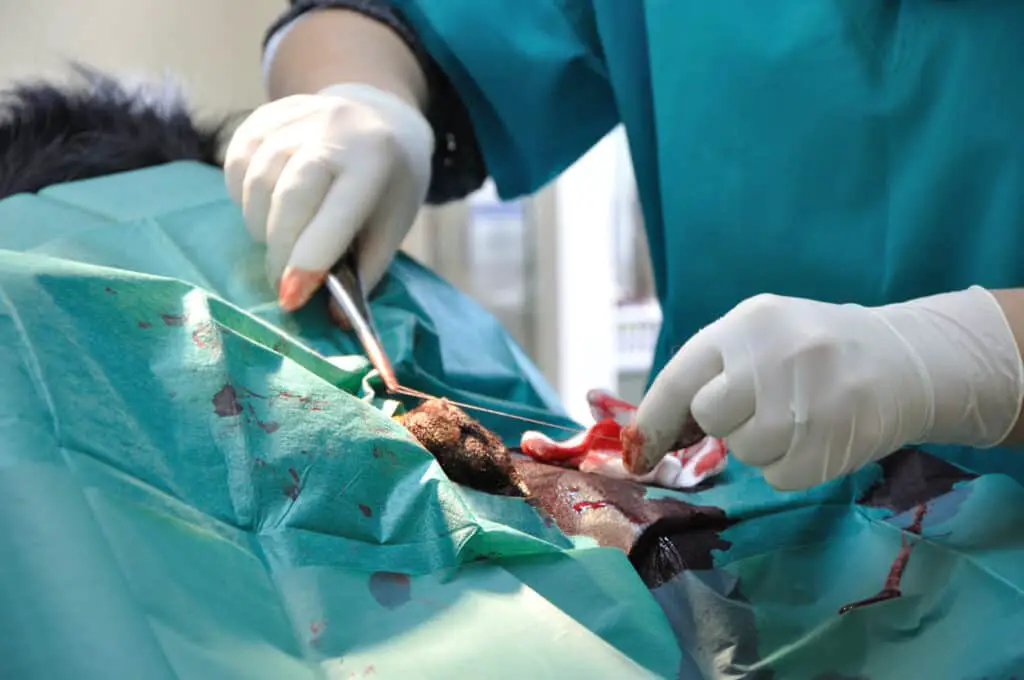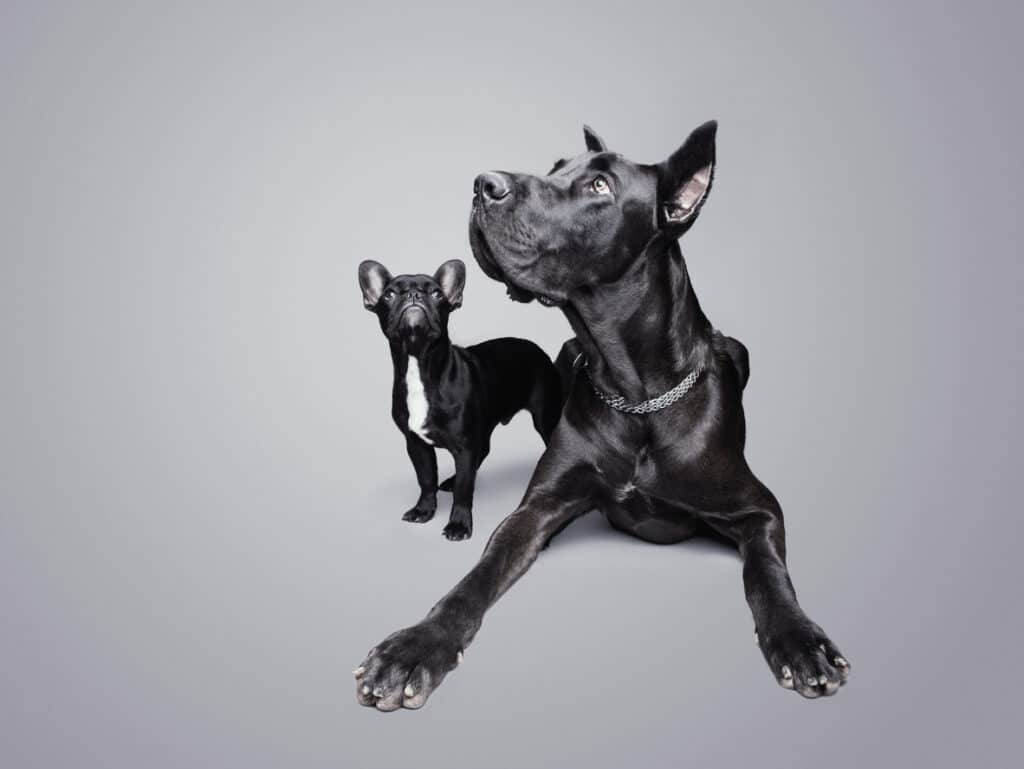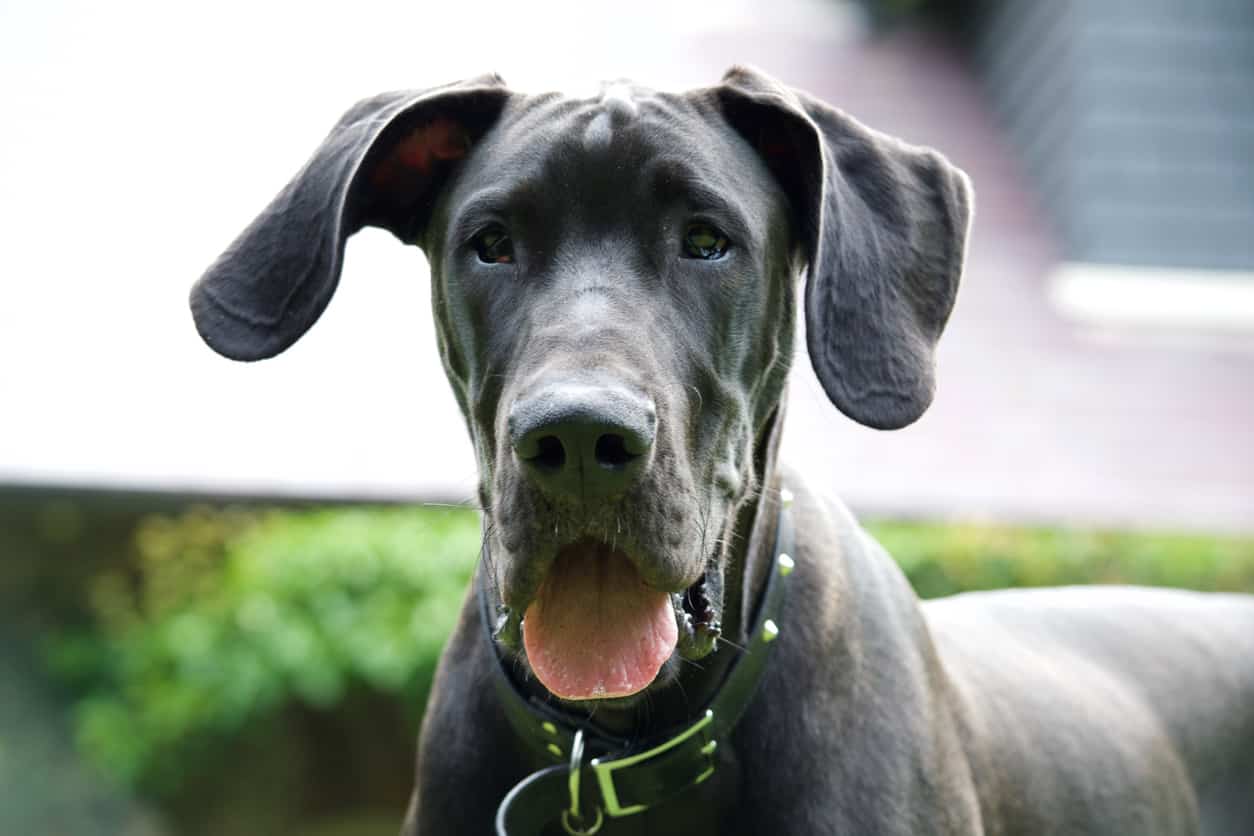With their imposing height and affectionate demeanor, Great Danes are one of the most recognizable breeds around. For breeders, veterinarians, and owners, they are also one of the most likely candidates for a stomach tacking procedure.
What is stomach tacking?

Also known as a gastropexy or simply a “pexy,” stomach tacking is officially referred to as prophylactic gastropexy (if it is performed preventatively) or as an emergency gastropexy if performed under life-threatening conditions such as bloat or gastric dilatation-volvulus (GDV).
Bloat is when air or gas fills a dog’s stomach and becomes trapped, resulting in pressure on the internal organs and diaphragm. As the condition progresses, the likelihood that the stomach will flip increases. It is also extremely painful to the dog. If the stomach flips or twists, it is called torsion and the animal can quickly deteriorate and die due to the blood flow to vital organs being cut off.
Great Danes are among the breeds most vulnerable to developing bloat and GDV and the condition is the number one health threat facing the breed. There is a 40% chance that a Great Dane will develop GDV in its lifetime. One of the main reasons Danes are especially vulnerable is related to their confirmation. Deep-chested large and giant breeds such as Great Danes (and Standard Poodles, German Shepherds, German Shorthaired Pointers, to name a few others) are at increased risk of developing bloat and GDV.
Due to this predisposition, many veterinarians now recommend stomach tacking (prophylactic gastropexy) as a preventative measure to protect against bloat and GDV.
What happens during a preventative gastropexy surgery?

There are three types of approaches available to veterinarians performing preventative stomach tacking procedures, laparoscopic and endoscopic. All three involve placing the animal under general anesthesia and it is therefore recommended that the procedure be performed on Great Dane puppies around one year of age in conjunction with a neuter or spay. This recommendation is to minimize the number of times an animal is placed under anesthesia, but also so that the recovery process for both the sterilization and the stomach tack can take place within the same time frame.
In a traditional gastropexy, after the anesthesia has been administered and the Great Dane is unconscious, a veterinarian will make two small incisions into the first layer of the stomach and the body wall. Each incision is about two inches long and they are then sutured together. This is the “tack” part of the procedure. During the recovery period, the sutured incisions with heal together, resulting in the stomach being held firmly in place. This operation takes around 35-45 minutes and typically costs between $200-$500.
In a laparoscopic gastropexy, after the anesthesia has been administered and the Great Dane is unconscious, a small incision is made near the belly button so that the laparoscope can be introduced into the abdomen. A second, slightly larger incision is made behind the last rib on the right, where the surgical instruments are introduced and then used along with the scope to grasp a small portion of the stomach and suture it to the inside of the abdominal wall. This operation takes around 35-45 minutes and typically costs around $1000.
The second type of preventative stomach tacking procedure is an endoscopic gastropexy. This approach is considered the least invasive because the endoscope is introduced through the mouth into the stomach and just one incision is needed to suture the stomach to the body wall. This type of procedure is general available at larger animal hospitals and typically costs over $1000.
Is elective stomach tacking worth it?

The general consensus within the veterinary and Great Dane community is that a preventative gastropexy is absolutely worth the cost for Great Danes, for several reasons.
- The number one health risk Great Danes face is bloat and GDV. While a preventative gastropexy does not eliminate the risk of bloat, it nearly eliminates the risk of torsion.
- The life expectancy of Great Danes is quite short, on average just 7-10 years. A preventative gastropexy is a proactive step owners can take to insure the longevity of their Dane.
- While the cost of the preventative surgery may seem high, the costs associated with an emergency gastropexy can be anywhere from $2000-$5000. The reason an emergency gastropexy is so much more expensive than its preventative counterpart is due to the increased risk of complications and more challenging surgical landscape in performing a gastropexy on a Great Dane suffering from bloat and/or torsion.
- While both a preventative gastropexy and emergency gastropexy have high success rates in preventing the stomach from twisting during a bout of bloat, there is a slightly greater chance that the tack won’t hold in an emergency procedure. That being said, Great Danes who receive stomach tacks after bloating have a greatly reduced likelihood of developing the condition again. There is a 55% chance that a Great Dane that bloats and does not receive a stomach tack will bloat again, whereas that number drops to 4% if the Great Dane receives a stomach tack after bloating.
- The risk owners take if they forego elective gastropexy and their dog develops bloat and needs an emergency gastropexy
- Post-operative care is much more manageable for Great Danes who receive a preventative stomach tack.
How to care for your Great Dane post-gastropexy
A Great Dane’s post-operative care for a gastropexy will depend on the type it received.
Ideally, the procedure was preventative and occurred in conjunction with a spay or neuter, around one year of age. Under these circumstances, Great Danes typically recover within 1-2 weeks. Throughout that time, they must be kept quiet and calm and prevented from running, jumping, or climbing. If you have small children in your house, it’s important to explain to them the importance of keeping the Great Dane calm. The Great Dane will require smaller meals than usual and must be prohibited from licking at its sutures.
It is also important to keep them warm as it is difficult for a Great Dane to regulate its body temperature following an operation. Some swelling at the incision site is natural and owners should apply a cold pack for five minutes 2-3 times per day for the first few days after the surgery. Any excessive redness, swelling, or discharge should be immediately reported to your veterinarian.
Post-operative care following an emergency gastropexy is much more involved. Many Great Danes require prolonged hospitalization (up to several days) for monitoring. The animal hospital may also prescribe a different diet or medications to promote gastrointestinal health. The recovery time for Great Danes who receive emergency gastropexies is typically between 2-6 weeks.
Can Great Danes still bloat if their stomach is tacked?
Yes, Great Danes can still bloat if their stomach is tacked. However, this is highly unlikely because the procedure is designed to minimize the risk of bloat occurring or reoccurring. There is just a 5% chance that your Great Dane will bloat again if it receives a gastropexy after bloating. The prognosis is even better for Great Danes who receive preventative gastropexies. Similarly to humans, the long term health outlook is drastically improved for Danes that undergo operations when they are young and strong. Additionally, Great Danes are at an increased risk of developing bloat as they age, making preventative gastropexy a sensible option.
If a Great Dane bloats when their stomach is tacked, what happens? (still need to go to the vet, but generally the tack holds the stomach to the wall)
If a Great Dane bloats with a stomach tack, they will still need to be taken to the veterinarian immediately. At present, there is no viable home remedy to cure bloat, and while a stomach tack can prevents a stomach from twisting, medical intervention may still be necessary to release the pent-up air or gas inside your dog. You can discuss purchasing over-the-counter gas relief pills to your Great Dane to ease their discomfort on the way to the vet, but this is not recommended by all veterinarians. If your Great Dane bloats, keep calm, call your veterinarian or the animal hospital and briefly provide them with the key details: suspected bloat in Great Dane (include symptoms here), the age and sex of the animal, and whether or not your Great Dane has a gastropexy and when the procedure was performed.
Signs your Great Dane may be bloating
- A distended stomach that is hard to the touch and sounds like a basketball when tapped (note: this tap should just be used to confirm your suspicion and not repeated as it will cause your Great Dane pain if it is indeed bloating)
- Unproductive retching and pacing in obvious discomfort
- Whining and biting at the stomach
- Heavy panting and unusual amounts of drool (may also appear foamy)
How to prevent bloat in Great Danes
Great Danes are at risk of developing bloat as a result of three main factors: confirmation, genetics, and environment. Their deep chest enables them to suck in large amounts of air, often when they are eating or drinking, which is why exercise should be carefully regulated in the hour before and after feeding your Great Dane. Many owners and veterinarians also highly recommend using raised feeders to feed and water Great Danes, although there is a split within the professional and pet-owning community as to the efficacy of this approach. Another option to research and discuss with your veterinarian is slow feeders.
Genetics play a huge role in predicting whether or a note a Great Dane will develop bloat. If you plan to purchase a Great Dane puppy from a breeder, one of the items on your list of questions should be if the puppies have an immediate relative who has bloated in the past. While an affirmation does not necessarily mean you should look elsewhere (after all, a little under half of all Great Danes will bloat at some point throughout their life), this information can help you in making future decisions, such as whether or not to schedule your Great Date a preventative gastropexy.
Stress is also cited as a key factor contributing to bloat in Great Danes. While they are affectionate and docile family pets, they are also highly sensitive and do not respond well to harsh training or chaotic homes. Their sensitivity can cause them to have a physical reaction to their environment, which is why providing your Great Dane with a consistent routine is so important. Note that consistent does not mean boring, but your Great Dane’s days should typically follow a reliable schedule. In conclusion, scheduling a preventative gastropexy can be seen as an investment in the long-term health of your Great Dane. Although the surgery is not cheap, it is far less expensive than an emergency gastropexy, and the post-operative recovery process is much easier to supervise in dogs who have received preventative stomach tacks.

